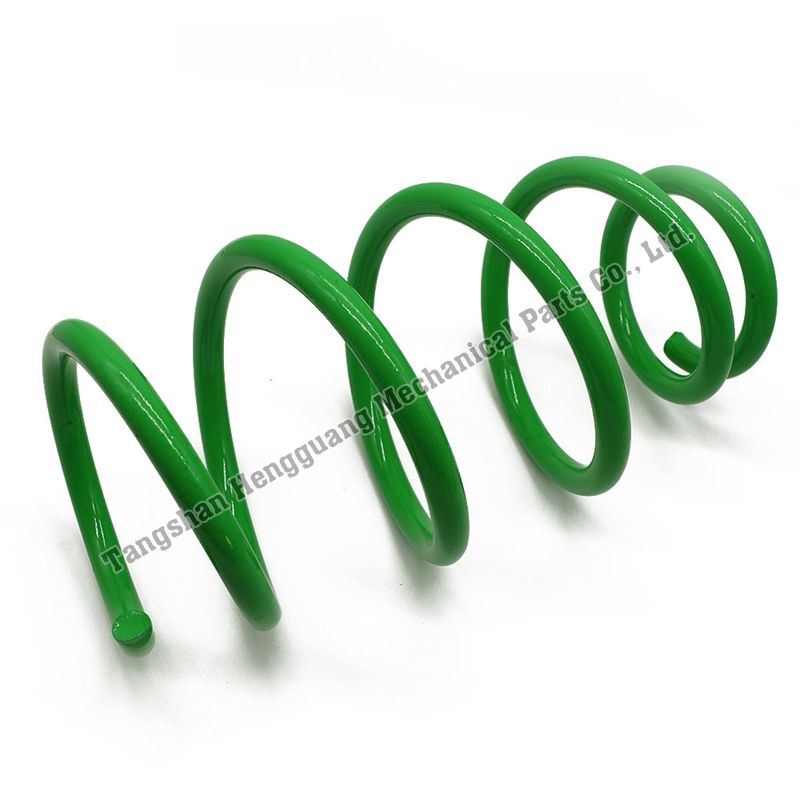The function of the Auto Suspension Coil Spring is to support the vehicle at the desired height, maintain the proper positioning angle and absorb road shocks transmitted through the tires and shock absorbers.
Constant flexing in normal service can gradually weaken the suspension system, allowing the car to sag. Once this sag becomes apparent, the entire car suffers. The steering components are forced out of position, thereby changing the geometry of the steering linkage. The loss of the original coil spring can only be fully recovered by installing a new coil spring. This will return the vehicle to the correct height.
Most steering linkages systems are designed so that the tie rod assemblies connect to the center link or rack at some angle. On these vehicles, with the steering linkage in front of the spindle, a sagging suspension will force the tie rod out-ward and cause a “toe out” condition.f the linkage is positioned behind the spindle on these vehicles, the outward force of the tie rods caused by the drop in suspension height will cause a “toe-in” condition.
The steering arm connection for vehicles equipped with rack and pinion steering have the same design characteristics and functions incorporated in parallelogram steering. Thus a change in vehicle height will have the same effect on toe change with either linkage system.

There are some linkage systems that are designed with all components approximately horizontal. A decrease in suspension height will cause these changes to be reversed, pulling the tie rods inward and produce the “toe-out” condition in
Incorrect ride height can also affect camber. As the vehicle begins to sag, the angle of the control arm changes. This change in suspension geometry and camber will greatly affect lateral wear or in-and-out motion of the tire as it rolls over irregular surfaces. Suspension systems are designed to minimize tire movement in and out; however, extreme lateral wear caused by geometry changes can lead to premature tire wear
A sagging suspension means that tires wear faster, some steering control and handling is lost, headlight aim is adversely affected, and vehicle appearance is marred.
COIL SPRING INSPECTION
A quick overall visual inspection will detect any obvious sag from front to rear or from side to side. Upon visual inspection under the car, look for the two ends of the control arms out of level, damaged or worn rubber bumpers and shiny or worn spring coils. All indicate weak coil springs.
Before visual inspection or suspension height measurements can be accomplished, the vehicle must be on a level surface, tires must be full and there should be no passenger or luggage compartment load. Beginning at the rear bumper, jounce the car up and down several times, proceed to the front bumper and repeat, releasing during same cycle as rear jounce.
More accurate inspection will reveal less obvious side-to-side sag by measuring heights at specific points on each side of the suspension system. If bumper is bent or damaged, compare ground-to-fender measurements taken at center of wheel cutout in fender. Allowable height difference should be no more than for ground-to-bumper measurement.
For accurate front-to-rear comparison, measurement points should be checked against manufacturer’s recommendations for the specific model, after determining that the vehicle is properly unloaded of abnormal cargo.
If inspection reveals a weak Coil Springs For Suspension Parts on either side, both sides must be replaced. Never attempt to avoid replacement by hiding the effect of a weak spring with any kind of insert, block or so called stabilizer. An insert will raise the vehicle height, but at the expense of handling and comfort. An insert virtually disables the coil it separates, and eliminates its ability to absorb shock. Further, the insert concentrates the stresses on a single point of the coil rather than distributing these forces throughout the spring. This simply accelerates fatigue and failure of the spring. Overload and air shocks are equally unsuitable as a means for overcoming sagging coil springs. These devices are designed to maintain proper vehicle height in overloaded conditions only.
Previous: Energy-Efficient Climate Control: Unveiling the Power of Monobloc Heat Pumps with Buffer Tanks
Copyright:@2020-2021
Comments Please sign in or sign up to post.
0
0 of 500 characters used